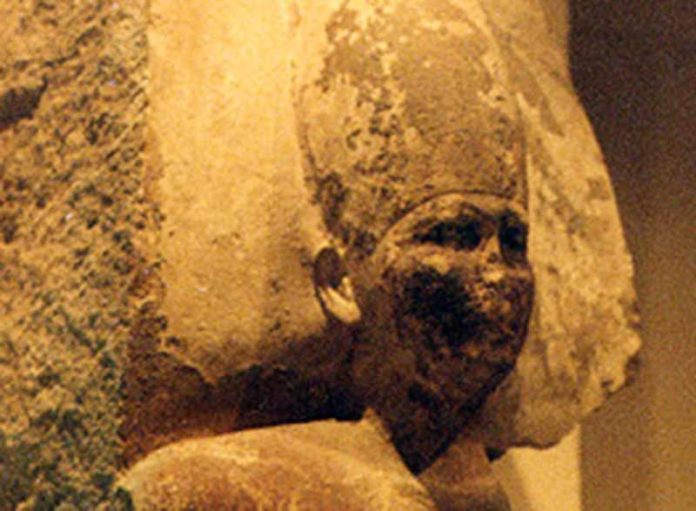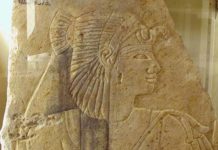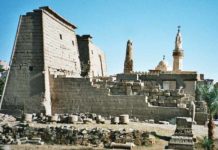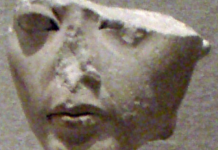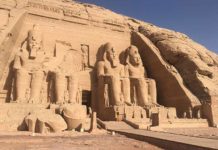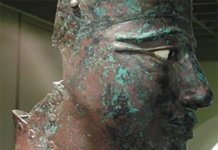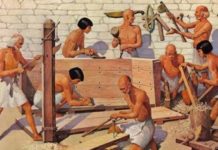Sneferu was so amiable he offered to replace a turquoise charm lost in the river by a palace lady. But he took prisoners and built several pyramids still seen today.
The charming tale written in the Papyrus Westcar describes how in order to ease the king’s boredom, several young beauties rowed him in his royal boat, clad in nothing but fish-net cloths. This story is quite whimsical, and Sneferu was in fact looked upon by later history as a very amiable sovereign. The Prophecy of Neferti, an otherwise pessimistic text of the Middle Kingdom, describes him as a beneficent king. Sneferu was son of King Huni, the previous king in Egypt, perhaps by a minor wife. Egyptian kings had several names as part of their royal titulary. His Horus name is Neb-maat, lord of the cosmic order; his birth name Sneferu means the one who performs perfection.
Amiable though he may have been remembered in story, in the Royal Annals on the Palermo Stone, it was reported that Sneferu’s raid into Nubia brought back 7,000 captives and 200,000 sheep and goats, and another expedition into Libya brought back 1100 prisoners and perhaps 23,000 animals. Inscriptions in that region dating to the Middle Kingdom, centuries later, even indicate he may have been deified and worshipped as a god. He also appears in the familiar smiting stance in two reliefs carved on the rock walls in a Wadi in the region. The exact length of his reign is uncertain: the Turin Canon gives him 24 years but year counts on building stones and quarry marks give him a reign of 46 years. His funerary cult continued well into the Middle Kingdom.
Marriage to Princess Hetepheres
Sneferu reigned from about 2613-2589 BCE, around the same time as the Royal Cemetery of Ur in Mesopotamia and of the building of Stonehenge in Europe. He married Huni’s daughter, princess Hetepheres. The Royal Annals report that Sneferu sent expeditions to the Sinai for turquoise, and to the Lebanon to fetch cedar which was used for the doors of the temples and to build his ships, and perhaps also in the fine jewelry and furniture buried with Hetepheres. Her tomb treasures can be seen in either the Cairo Museum or in the Museum of Fine Arts in Boston.
Builder of Pyramids
Although his predecessors set their burials in the Saqqara and Memphis area, Sneferu moved his court first to Meidum and then to Dahshur. By his reign, the Step Pyramid of Djoser at Saqqara was the only pyramid in Egypt. While the three Pyramids of Giza are most famous, Sneferu built himself more pyramids: three massive pyramids and a smaller pyramid–the total mass of stone from all four exceeding the total from the Great Pyramid alone.
The Meidum Pyramid
The Meidum pyramid, called Djed Sneferu or Sneferu Endures in ancient times, was begun as a step pyramid, like the previous one built by King Djoser at Saqqara. It was built in stages with eight steps. Years later, Sneferu had that filled in so that it took on the form of a true pyramid.
The Dahshur Pyramid
He then moved his court to Dahshur, 28 miles north of Meidum. Perhaps he chose the new location to be closer to the trade routes with the Levant. For whatever reason, here Sneferu built not one, but two new pyramids. One of these Dahshur pyramids is called the Bent; and the other is called the Red pyramid.
Bent Pyramid
Although in antiquity this pyramid was known as The Southern Shining Pyramid, it earned its current name from its odd shape. It began as a smaller pyramid but developed structural problems. When the builders decreased its slope, the pyramid took on its distinctive bend. Sneferu then decided to build his next pyramid. It was recently announced that tourists can visit the inner sections of the Bent pyramid if they wish.
Sources:
- Baker, D. (2008). Encyclopedia of the Egyptian Pharaohs, Vol I. Bannerstone Press.
- Lehner, M. (1997) The Complete Pyramids Thames&Hudson, Ltd.
- The Oxford Encyclopedia of Ancient Egypt (2001). Oxford University Press.


